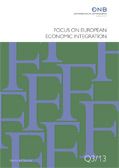Focus on European Economic Integration Q1/19
 OeNB
OeNB
- published:
- March 2019
 OeNB
OeNB
Call for applications:Klaus Liebscher Economic Research Scholarship (PDF, 50 kB) de Mar 4, 2019, 12:00:00 AM
Household debt in CESEE economies: a joint look at macro- and micro-level data (PDF, 1.1 MB) Riedl. Household debt can constitute a major risk to macrofinancial stability. This paper presents an overview of potential vulnerabilities stemming from household debt in ten Central, Eastern and Southeastern European (CESEE) economies, using the most recently available data. Unlike other papers that only evaluate macrofinancial risks, we take a complementary view on household debt. First, we provide several indicators based on macro-level data that are frequently used to assess macrofinancial risks. Second, we employ unique and newly available data from the OeNB Euro Survey conducted in fall 2017 to arrive at several vulnerability indicators that have not been available for most of the CESEE economies so far. Our analysis does not aim to provide a final risk assessment by evaluating all indicators within an elaborated analytical framework but to highlight the advantages of jointly looking at macro- and microlevel indicators when assessing macrofinancial risks. en bank loans, DSTI, macrofinancial risk, household vulnerabilities, emerging Europe E43, E44, G01 Mar 4, 2019, 12:00:00 AM
How useful are time-varying parameter models for forecasting economic growth in CESEE? (PDF, 832 kB) Feldkircher, Hauzenberger. Empirical evidence has shown that a prerequisite for generating reliable macroeconomic forecasts is either the inclusion of a large information set or modeling time variation in the models’ parameters and volatilities. In this paper we examine these claims in a comparative manner, forecasting GDP growth for six CESEE economies. We use Bayesian techniques and evaluate the models based on both the accuracy of their point forecasts as well as the degree of uncertainty surrounding these predictions. Our results indicate that forecasts from a fully-fledged time-varying parameter model tend to outperform those from its constant parameter competitors. Adding more information, e.g. from other countries, by contrast, does not improve forecast performance significantly for most of the countries under study. Last, we analyze whether it pays to forecast GDP growth indirectly by summing up forecasts of GDP components. This approach yields competitive forecasts, yet it preserves an economic interpretation of the underlying drivers for the economic growth forecasts, which is of crucial importance from a practitioner’s view. en forecasting, CESEE, time-varying parameter, aggregate GDP forecast C11, C32, C53, E17 Mar 4, 2019, 12:00:00 AM
Migration intentions in CESEE: sociodemographic profiles of prospective emigrants and their motives for moving (PDF, 743 kB) Raggl. What are the characteristics of prospective emigrants from Central, Eastern and Southeastern Europe (CESEE)? How many people intend to move? We use data from the 2017 wave of the OeNB Euro Survey to study migration intentions among individuals in CESEE. Our descriptive findings suggest that 8.3% of individuals aged 25 to 64 have the intention to move abroad within the next year. Migration intentions are considerably more common among young people and men. In most of the countries, we do not find significant differences related to educational attainment. The prevalence of migration intentions varies considerably across countries: In non-EU CESEE countries migration intentions are more widespread on average than in CESEE EU countries. Probit estimations confirm our descriptive findings. They further highlight that individual unemployment is a robust predictor of migration intentions in CESEE, while household income is not significantly related to migration intentions. The level of regional development plays a key role in shaping migration intentions, and so do (direct and indirect) networks and trust in institutions. Finally, we find that the level of regional economic development also influences the magnitude of the push effect of individual unemployment. For individuals living in depressed regions, the positive correlation between unemployment and migration intentions is higher. en migration intentions, individual-level data, probit, principal component analysis, CESEE J61, F22, O52 Mar 4, 2019, 12:00:00 AM
Online appendix to: Migration intentions in CESEE: sociodemographic profiles of prospective emigrants and their motives for moving (PDF, 226 kB) en Mar 4, 2019, 12:00:00 AM
Conference on European Economic Integration 2018: How to finance cohesion in Europe? (PDF, 174 kB) en Mar 4, 2019, 12:00:00 AM
“Connecting Europe and Asia” – conference summary (PDF, 115 kB) en Mar 4, 2019, 12:00:00 AM
Referees for Focus on European Economic Integration 2016−2018 (PDF, 97 kB) en Mar 4, 2019, 12:00:00 AM